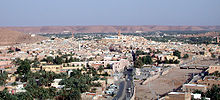M'Zab Valley

Panoramic view of Ghardaïa (Tagherdayt) with the dry bed of Wadi M'zab on the right side.
|
|
| UNESCO World Heritage Site | |
|---|---|
| Location |
Algeria |
| Criteria | ii, iii, v |
| Reference | 188 |
| Coordinates | 32°29′14″N 3°40′53″E / 32.48722°N 3.68139°ECoordinates: 32°29′14″N 3°40′53″E / 32.48722°N 3.68139°E |
| Inscription | 1982 (6th Session) |
| Website | www |
|
[]
|
|
The M'zab or Mzab, (Mozabite Aghlan, Arabic: مزاب), is a natural region of the northern Sahara Desert in Ghardaïa Province, Algeria. It is located 600 km (370 mi) south of Algiers and there are approximately 360,000 inhabitants (2005 estimate).
The Mzab is a limestone plateau, centred on the Wad Mzab (Oued Mzab) valley.
The Mozabites ("At Mzab") are a branch of a large Berber tribe, the Iznaten, which lived in large areas of middle southern Algeria. Many Tifinagh letters and symbols are engraved around the Mzab Valley.
After the Muslim conquest of the Maghreb, the Mozabites became Muslims of the Mu'tazili school. After the fall of the Rostemid state, the Rostemid royal family with some of their citizens chose the Mzab Valley as their refuge. However, the Rostemids were Ibadi and sent a preacher (Abu Bakr an-Nafusi) who successfully converted the indigenous Mozabites.
France occupied Algeria in 1830 and removed it from Ottoman domination. The M'zab was annexed to France only in 1882 and reverted to Algerian indigenous rule in summer 1962 upon its national independence. Ghardaia (Taghardait) is the main town and capital of the M'zab, while el-Ateuf (Tajnint) is the oldest settlement in the region. Beni Isguene (AT'isgen) is the most sacred Berber Islamic town. It prohibits all non-M'zabites from various sections of this town and all foreigners from spending the night within its walls. Melika (AT'mlichet) is populated by a kabily town named Mlikch which is untell now located near Bouira city, and it contains spacious cemeteries and a historical Mosque in the center of the K'sar, while Bounoura (AT'bounour) is a historical K'sar which contain Azwil palm grove, while El-Guerrara (Igraren) and Berriane (Iberguen) have been part of the M'zab since the 17th century.
...
Wikipedia

